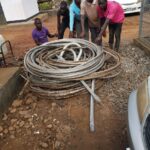
September 24, 2020 2:58 pm
The concept of electricity losses has always confused and disturbed many customers not only in Uganda but world over. It is not unusual to hear a customer ask, “but where does it [electricity] disappear to?” In this article, I will try to explain what this concept of electricity loss is to an ordinary customer in Rwamunena Shuuku Town Council Sheema District. Electricity loss happens when the total energy consumed (by individual consumers) is less than the total generated and dispatched energy. This means there is an amount of energy that is not accounted for as electricity is transmitted and distributed to the final consumer.
Electricity is lost in two ways/forms i.e. technical loss and commercial loss, also known as non-technical loss. The technical losses, in a complete electricity supply system, are also categorized into transmission loss (losses incurred along the transmission network) and distribution loss (losses incurred along the distribution network). Technical losses arise when electrical energy is used to overcome the resistive properties of electricity supply infrastructure. Naturally, electricity wires (conductors) and associated connectivities resist the natural flow of electricity through them. Considerable amount of force is used to overcome this resistance. This is evidenced by the generated heat within the wires as electricity does this “work”. . So what does this mean? When electric current flows through power lines, part of it is used to “fight off” the natural resistance to enable smooth flow. Hence some electrical energy is lost within the wires as the bigger part is transmitted and delivered to the final consumer.
So, how do transmission technical losses arise? Electricity is generated and transmitted as current at an appropriate voltage level. So, when power is generated from Kiira and/or Nalubaale power station, the generated voltage is stepped-up in order to achieve efficient transmission. It is transmitted in bigger electric wires [conductors] to another location (Primary substation), say Lugogo in Kampala or to any other transmission station in the Country. From Kampala in our example it is transmitted in the similar bigger conductors to Mbarara transmission substation.
During transit, the current in electricity ends up heating as it tries to overcome resistance of the conductors. There are no conductors in the world that do not have resistance and as such, the transmission company has to accept this loss. Resistance of the conductor [copper] wire is dependent on the conductor surface area and the length of the conductor. The smaller the conductor, the bigger the resistance and the higher the loss and vise-a-versa.
The power transformers step up the voltage with an aim of reducing the transmission current so that there is minimal losses along the line. The point is that you want to transmit an amount of power from one location to another. You want to take it with minimal losses. So, as the conductors [wires] traverse long distances, the amounts pumped out at Kiira and Nalubaale reduces and by the time it arrives in Kampala, there is less than what was pumped out at the power transformer. At the transmission station, transformers are connected to step-down the voltage to lower the current so that we can transmit/distribute with minimum losses.
At this stage, no one tapped onto the transmission line, no one stole electricity, but it got lost along the way through work done against the resistive properties of the wires trying to overcome resistance in the conductors. Resistance along wires increases with length and decreases with cross-sectional area. Larger wires have a lower resistance than smaller ones. Resistance increases as length increases, so the losses will increase along longer distance transmission lines. As a result, there is less energy than what was pushed through at the power transformer.
Whereas there is a step-down transformer at the transmission substation, this transformer cannot recover the lost current to the load pushed through by the power transformer at Kiira and Nalubaale power station. As a result, there will be a loss. The question then becomes, who bears/pays for this kind of loss? I will come in another article to answer this question.
Whole cycle from Generation to Distribution to our final residences.
So, the other question would be, aren’t there transmission losses arising from inefficiencies of the transmission company? Yes, there could be losses that arise from failure of the transmission Company to for instance maintain the transmission grid. Where a system transmission company fails to replace transformers with correct sized transformers, fails to improve the connection quality of conductors or fails to manage the reactive power by installing capacitor banks along transmission lines. The regulator always sets targets that aim at reducing the inefficiencies of the transmission company. All these, I will come to explain in my subsequent articles.
At this stage, there is loss unaccounted for which is observed at the end of the transmission line and this is what Electric Engineers call Transmission Technical Loss.
DEMYSTIFYING THE CONCEPT OF ELECTRICITY DISTRIBUTION LOSSES
Electricity distribution losses are of two forms i.e. technical and non-technical (commercial) losses. Technical distribution losses arise from a number of factors. As earlier observed on transmission technical losses, distribution technical losses also happen as a result work done to overcome conductor resistance. This resistance is also affected by the size of the conductor, the distance the power line travels as well as the state of the conductor. The bigger the size of the conductor, the lower the resistance, the lesser the wasteful work to be done and subsequently the lower the losses. On the other hand, when conductors are small, travelling a long distance, there will be strong resistance that will require a lot of current to overcome hence generating too much heat. That too much heat will lead to too much losses.
Distribution technical losses also arise from the state of the conductors. Lose joints / connections, old / worn-out conductors with gaps between strands contribute to technical losses. This is because the air in between the lose connections or gaps in strands works as an insulator which then increases the resistance, hence demanding more “wasteful work” to allow smooth flow. The more jointed the conductors, the higher the losses that will ensue. Other technical losses are due to the load on the distribution transformers, ideally to achieve maximum efficiency from a distribution transformer, it should be loaded between 50% and 60% loading. Higher loadings above 60% increase losses but these losses are compensated [somehow] with increased power sales the company makes.
From the three ideal causes of technical distribution losses, there those losses that a distribution company can reduce or manage and those that the distribution company has to live with. The losses that cannot be removed but can minimized for instance those arising from the current reducing as a result of work down trying to overcome conductor resistance. The distributor will likely transfer such losses to the consumer. This is the concept that traders worldwide use.
When Mr. Musa is a wholesaler of Matooke. He loads matooke from Kabwohe having bought them from different farmers (call them generators), Mr. Musa drives his canter through Mbarara, Masaka and finally to Kampala in Kalerwe market to sell to M/S. Nampijja [the Retailer/ Distributor]. On loading, some batches will have lost some banana fingers, others will have ripened, others will have been crushed and a good number of batches will be good to sell. For Mr. Musa to remain in business, he will increase the price of the good batches to ensure he recovers the cost of even those which ripened or got smashed or lost figures beyond sale. From this illustration, Mr. Musa did nothing wrong along the chain but because of resistance inform of temperature (sun/heat), distance, condition of the vehicle, he unfortunately loses some matooke. That is what happens with technical losses.
Clockwise: Farmer/Generator, Transmitter, Wholesale, and Retailer/Distributors
From this illustration, when the vehicle has old tyres and keep busting along the way, Mr. Musa will take longer on the road hence increasing on the number of batches that will ripen, if he overloads the canter, the matooke will be too squeezed again will ripen, lose shape and get-off the batches. And the longer the distance, the more damage that will happen/be caused on his stock. Matooke transported from Kabwohe to Mbarara (32Km) will have less damage compared to the one that goes up to Masaka (171Km) or Kampala (298Km).
A commercial loss on the other hand arise where the metered energy/sold energy from all your customers is less than purchased energy from the transmission company less technical losses. It can even be brought closer to the difference between energy sales/units from customers and the energy sales/units at distribution substation or transformer point. These losses will come from a number of actions. Some of these actions are within control of the distribution company while others are not. Some losses arise from un-metered energy which could be due to fault on the meter or customer left without a meter by a distribution utility for one reason or another, stealing/tapping, meter tempering or erroneous reading of the meter by the staff. When such happens, the sold energy is less than what was actually bought.
In our illustration of selling matooke, M/S. Nampijja [the distributor/ retailer] in Kalerwe has received matooke which is relatively fine but some could get ripe as he waits for the customers, if there is a riot, some could be stolen, kifesi guys could even steal it if he is not careful or he could underprice forgetting that some batches have ripened. All these are risks that the retailer will manager. If he has another stall in Kibuye and Kireka, he still risks the transportation challenges of getting ripe, losing some banana fingers or losing the whole batch in the process.
At times, M/S Nampijja will disappoint customers with slow delivery, untimely service, and increase in price if Mr. Musa delays to deliver the matooke in time. This could be due to the status of the vehicle, status of the road. At times, the price will change because the season [exchange rate, fuel prices] is bad may be rainy and the roads are slippery for vehicles that carry matooke from the villages to come to Kabwohe. All these will affect the price of the final batch in Kireeka, Kalerwe or Kibuye markets.
I hope you have understood the concept of electricity losses, the next question then is, who bears the cost of all these losses. I will be back in my subsequent articles to address the issue of who bears the cost of these losses.
By Michael Taremwa Kananura










